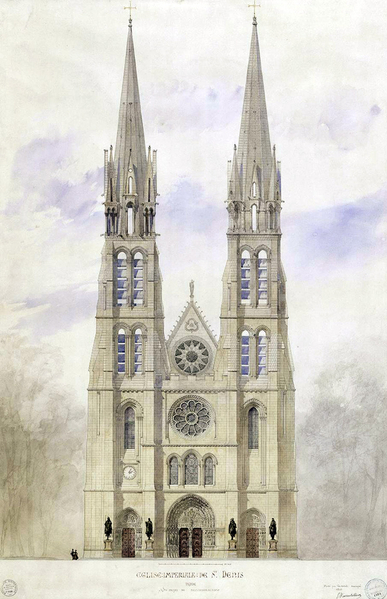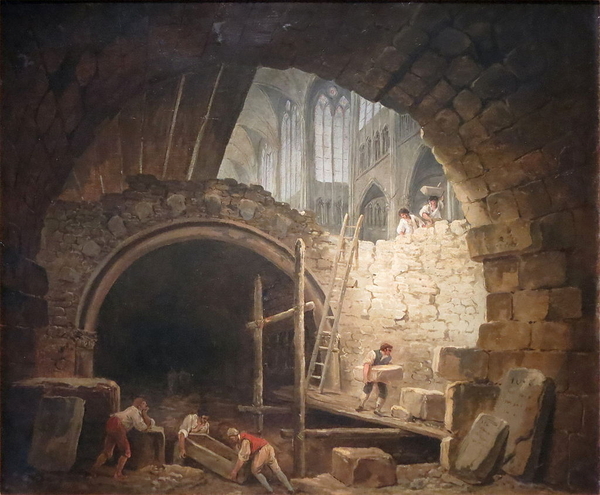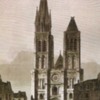The Basilica Cathedral of Saint-Denis, on Paris's northern doorstep has a unique place in French history. Notre Dame gets the crowds, the Cathedral at Reims is where French kings were crowned, but Saint-Denis is uniquely the end of the road. It's where French kings are entombed, along with queens, princes, princesses and other royals.
Since the French kingdom goes back over a thousand years, and a couple of hundred more if you go back to Charlemagne's sons, that's a lot of tombs, as becomes obvious almost from the moment you enter the imposing, which has a rather odd history of its own.
But let's start with the tombs. There's a crypt under the altar that goes back to the 10th century, and accounts for a lot of ancient burials and sarcophagi, and also a number of tombs from the 18th and 19th centuries, but the floor level, on both sides of the nave, are where the main display is.
In this area, there are numerous (and I did try briefly to count) stone and marble monuments in varying styles and degrees of elaborate imagery. As you look around and notice that the names go back to Charlemagne's 8th-century sons, it become clear these are not the original tombs. In the middle of the 13th century, Louis IX, King St Louis, instigated several decades of marble-mania, in which elaborate tombs were built, and remains that had been in the crypt or in other cities and churches found their way there.
Among my favorites: while most feet are shod or draped, several display carefully-modeled and not necessarily-perfect toes. George G recognized them in our One-Clue Mystery this week.
During the French Revolution, when neither church nor monarchy were popular, many of the tombs still in the crypt, including the remains of the most recent kings and their families, were destroyed and scattered. That's the scene below in a painting by Hubert Robert. During the Bourbon restoration, after Napoleon, considerable effort went into gathering, repairing, and in the case of remains, re-assembling.
Following the stairs below the altar leads to the ancient crypt, which now looks like this:
Adjoining the ancient crypt, a newer section was created in the early 19th century as part of the restoration work; Napoleon reconsecrated the church in 1806 and planned to be buried there along with his future descendants. Instead, after Napoleon's death, the ashes of the deposed and executed Louis XVI and his family were brought and interred with great ceremony.
Although no French king has been entombed at Saint-Denis since Louis XVIII in 1824, there has been more recent activity. Louis XVII, son of Louis XVI and Marie Antoinette, outlived his father by two years, then died at the age of ten. As far as monarchists are concerned, he ruled France for those two years, not the Revolutionary government. In 1975, after scientific confirmation, his mummified heart, in a glass vessel, was added. Don't ask. Just don't.
Also in the lower area, a woman with more titles than almost anyone could imagine: Marie Therese of (Spain) (Austria) (France) depending on how you look at it. She was born in Spain, eldest daughter of Philip IV of Spain, and by birth also Infanta of Portugal, and Archduchess of Austria. And then she married Louis XIV and became Queen of France and Navarre. The plaque calls her the 'Very High Very Powerful and Virtuous Princess.'
But perhaps it's time to go back for a moment to the history of the church itself. The site is the reputed burial place of Saint Denis, an early missionary who was beheaded on Montmartre (Mount Martyr) by Roman authorities around 250 AD. In legend, he picked up his head and walked about about five miles to the site of the church; while he held his head, it spoke a sermon and asked to be buried there.
The first church on the spot came early in the fourth century, honoring his grave. A century or so later, Saint Genevieve (who may or may not have been one person, or several stories merged into one) added to the building, turning it into a basilica. A century of so later Dagobert I, King of the Franks, turned over to the Benedictines, who built the Abbey of St Denis around it. Move on another hundred years, and in 775 Charlemagne is on hand for the consecration of an even newer church.
On to the 1100s. By now, more kings, more tombs, not enough space and glory. And the ambitions of Abbot Suger, confidante of kings and ace fundraiser, though sometimes by means best not discussed. Suger completely rebuilt the church over a ten-year period in the mid-1100s, creating what has been called the first major building to incorporate all the aspects of Gothic architecture. Suger died before the nave itself was redone.
But, as usual, that was not the end of building and fixing; his successor redid the nave in a 'rayonnant' style of Gothic and with the idea that it needed to be big enough to be the royal necropolis for a long time after. And that loops us back to King St Louis, who began commissioning tombs and rearranging the graves of his predecessors: Carolingians here, Capetians there, and space for more.
The building and adding continued in fits and starts until the Revolution. Because it was so close to Paris and so closely associated with the royal family, it was an early target. In late 1792, the medieval abbey buildings were pulled down and the church used as a grain warehouse. But most of the sculptures were saved and a commission appointed to decide which ones to keep, a job they never finished.
In 1813, Francois Debret was given the job of chief architect of the Cathedral, and spent thirty years restoring, repairing, and adding new windows that emphasized royal figures even more.
 His success at that work didn't extend to other projects; he wasn't well-versed in Gothic architecture and engineering. When the left tower (you'll notice it's missing in the picture near the top) was destroyed by lightning in the early 1840s, Debret rebuilt it and topped it with a rather over-bearing spire.
His success at that work didn't extend to other projects; he wasn't well-versed in Gothic architecture and engineering. When the left tower (you'll notice it's missing in the picture near the top) was destroyed by lightning in the early 1840s, Debret rebuilt it and topped it with a rather over-bearing spire.
Unfortunately, it was more than the structure could bear, and spire and tower collapsed in 1845, along with Debret's career. He was replaced by Eugene Viollet-le-Duc, later noted for restoring Notre Dame.
Viollet-le-Duc, never known for thinking small, restored most of the damaged tombs, rearranged them, and, in essence, creating a museum of French sculpture. He also designed, at the request of Napoleon III, a crypt for himself and his dynasty. The 1870 Franco-Prussian war ended the project and dynasty.
One aspect of Viollet-le-Duc's plan that was never executed due to loss of funds, was to rebuild the left tower, and provide spires for both towers.
 But the desire for spire appears to be eternal, and after years of discussion, a plan to restore it according to Debret's plan was approved in the early 1990s, but went no further because the approval didn't come with funds. Like all of France's cathedrals, it is owned by the state, but church and other organizations are largely responsible for maintenance.
But the desire for spire appears to be eternal, and after years of discussion, a plan to restore it according to Debret's plan was approved in the early 1990s, but went no further because the approval didn't come with funds. Like all of France's cathedrals, it is owned by the state, but church and other organizations are largely responsible for maintenance.
Work is now scheduled to start next year due to an unusual circumstance: So much was contributed for the restoration of Notre Dame, that local authorities have directed €20 million or so for the St Denis tower and spire.
The unusual title (Basilica Cathedral) has long roots. While never officially designated as a basilica by the Catholic Church, it's been called that for centuries. Its status as a Cathedral is quite new: Saint-Denis became a diocese for the first time in 1996, separated from the Archdiocese of Paris.
Visiting Saint-Denis Basilica from Paris is quite easy: It's the second-to-last stop on the Metro 13 line; around the corner is the lively Saint-Denis market, which spills out of the market hall into surrounding blocks. A short walk or one Metro stop away is the Saint-Denis Museum, which covers the history of the Abbey, the town and the Paris Commune.





Comments (0)